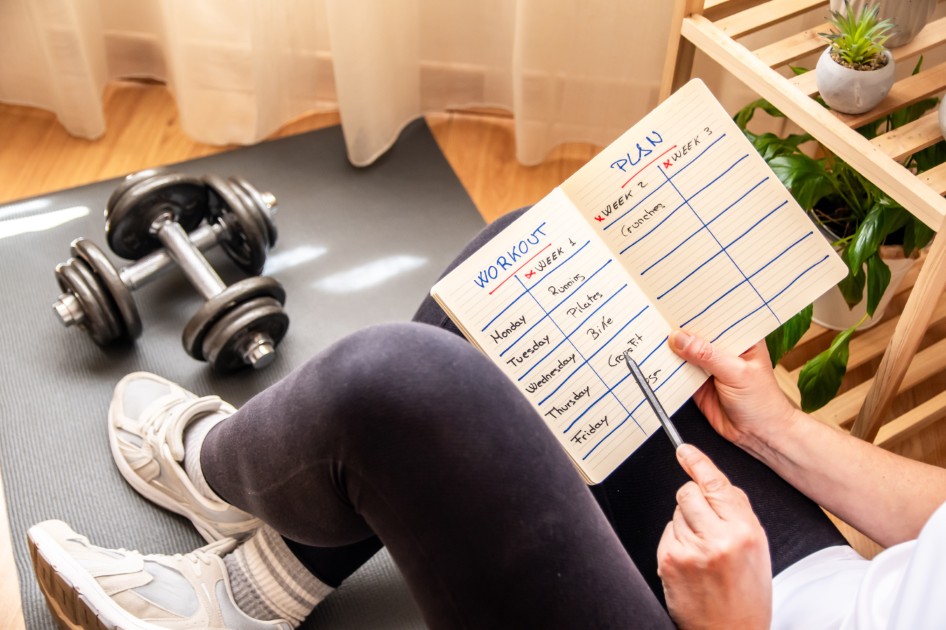Introduction
Have you ever felt like your fitness progress has suddenly stalled? Perhaps you’re lifting the same weight as last month, the scale refuses to budge, or your running pace flatlined. Hitting these plateaus can be frustrating for beginners and experienced athletes alike. The good news is that tracking your progress and adjusting your approach can help you break through these lulls. By using the right tools, staying consistent, and adopting a positive mindset, you can turn plateaus into mere pit stops on your journey to greater strength, weight loss, or muscle gain. In this article, we’ll explore how to track physical progress effectively, which apps can help, and the science-backed strategies (both physical and psychological) for overcoming plateaus in your fitness journey.
A group of athletes is ready to run, symbolizing the start of a fitness journey. Whether you’re just beginning or a seasoned athlete, tracking where you started and how far you’ve come is key to long-term success.
Why Tracking Your Progress Is a Game-Changer
Progress tracking is more than just note-taking – it’s a proven technique to boost motivation, accountability, and results. Research shows that no matter what your fitness goal or method is, you’re more likely to succeed if you diligently monitor your efforts. In a Stanford-led analysis, people who closely tracked their weight, workouts, or diet with digital tools lost more weight than those who didn’t – essentially, the more consistently you track, the more weight you tend to lose med.stanford.edu. Another large-scale study quantified this effect: individuals lost significantly more body weight during months they faithfully logged their stats (body weight, food, or exercise) compared to months they tracked infrequently. In fact, those who kept up daily monitoring of weight or diet saw over 2% additional weight loss per month versus their low-tracking periods.
Why does tracking make such a difference? For one, it creates accountability – you can’t ignore what’s written in black and white (or displayed in an app). Tracking also provides feedback and tangible evidence of improvement (or patterns that need changing), which fuels motivation. Psychologically, recording each workout or meal turns abstract goals into concrete data. You’re able to see trends, celebrate small wins, and adjust quickly when something isn’t working. Over time, this habit of self-monitoring becomes part of your routine. Experts note that habits form through repetition and reward loops; each time you log a workout and see progress, your brain’s reward system (dopamine) reinforces that behavior, psychologytoday.com. In other words, tracking progress not only measures success – it actually helps train your brain to crave the actions that lead to success.
Top Tools and Apps for Tracking Physical Progress
You don’t have to track progress with pen and paper (though you can!). Modern fitness apps and gadgets make self-monitoring easier and even fun. Here are some popular tools tailored to various fitness goals and how they keep you on track:
- MyFitnessPal or Noom (Nutrition & Weight) – Great for logging daily food intake, calories, and weight. These apps provide charts of your weight trend and feedback on your diet. In fact, diet-tracking apps and digital scales can increase engagement and help users shed more pounds by making calorie-counting and portion tracking more convenient. If weight loss is your goal, try logging meals a few times a week – consistency has been linked to better results.
- Strong, Jefit, or Fitbod (Strength Training) – These workout log apps let you record sets, reps, and weights for each exercise. Over time, you’ll see if your squat or bench press is trending upward. Many also graph your total training volume. Recording your strength sessions ensures you’re following the principle of progressive overload (more on that soon) and signals when it might be time to increase the weight.
- Strava, Garmin Connect, or Nike Run Club (Endurance & Cardio) – If you’re a runner, cyclist, or all-around cardio enthusiast, apps like Strava track your runs, rides, swims, and even gym sessions in one place. For example, one editor raves that Strava allows you to track everything (runs, bike rides, even kitesurfing) and saves all workouts in one spot so you can review your weekly accomplishments at womenshealthmag.com. These apps give you insights on pace, distance, heart rate, and progress over time. They often include social features too – you can share achievements with friends and even set weekly goal challenges to stay motivated.
- Fitness Wearables (Fitbit, Apple Watch, etc.) – Wearable fitness trackers automatically monitor metrics like steps, heart rate, and sleep. Syncing them with their companion apps provides a daily and weekly report of your activity levels. This constant feedback can nudge you to hit that 10,000-step goal or get more sleep for recovery. Many wearables also have built-in workout logging and will alert you when you’re near your targets.
Pro tip: Whichever tool you choose, the key is consistency. Set aside a minute or two after each workout or each day to log your info. These apps can also remind you to record your data. Over time, you’ll build a rich log of information that not only shows how far you’ve come but also clues you in to what works best for your body.
Understanding Fitness Plateaus (and Why They Happen)
So you’ve been tracking diligently and making steady progress – then suddenly, the graph flatlines. Welcome to the plateau, a normal (albeit annoying) phase in any fitness journey. A fitness plateau is essentially when your improvement stalls out despite continued effort. Weight loss plateaus are common after an initial drop in pounds, and strength/muscle plateaus often hit lifters after newbie gains taper off. Understanding why plateaus happen will help you overcome them.
A conceptual road sign illustrating a weight loss crossroads. Hitting a plateau can feel like reaching a dead end, but research shows it’s actually an expected adjustment phase on the road to long-term success.
Physically, plateaus often occur because your body has adapted to your routine. In strength training, muscles and the nervous system become efficient at your current workout regimen, so they don’t need to grow stronger or bigger to handle it. In weight loss, your metabolism may slow down as you lose mass, and hormonal changes can increase hunger while decreasing energy expenditure – a biological reaction that impedes continued weight loss, newatlas.com. In fact, during calorie restriction, the body undergoes “biological adaptations, a decreased resting metabolic rate, and hormonal changes” that can stall fat loss and even make you feel more fatigued. Essentially, your body is hitting the pause button to recalibrate to its new normal.
Psychologically, plateaus pack a punch too. After weeks of seeing progress, it’s demoralizing to suddenly see no change. This abrupt halt can lead to discouragement and tempt you to quit. You’re not imagining it – the motivation dip during a plateau is real. One 2025 study of over 6,500 dieters found that most experienced at least one multi-month plateau, which is exactly when people were most likely to give up on their program, newatlas.com. But here’s the flip side: those who stuck with it pushed past the plateau and went on to lose significant weight over the year. The lead researcher emphasized that “weight loss isn’t linear. Periods of maintenance and small regains are normal – but with persistence, meaningful results can happen.” In other words, a plateau is not a dead end – it’s a speed bump. It signals that your body is adjusting, and if you stay consistent and make a few tweaks, you can get back to making progress.
Physical Strategies to Overcome Plateaus
When progress stalls, it’s time to change things up and challenge your body in new ways. Here are several science-backed strategies to break through a plateau and restart physical improvements:
- Apply Progressive Overload: The principle of progressive overload means gradually increasing the demand on your body – lifting heavier weights, doing more reps, or running a bit farther or faster. If you keep doing the exact same workout every week, your body simply maintains. By upping the intensity or volume slightly, you force new adaptation. For example, try to add 5-10% more weight to your lifts over a few weeks or reduce rest intervals in your cardio sessions. Even a small weekly increase (e.g., 5 extra pounds on a lift or 5 more minutes of cardio) can spur new gains while minimizing injury risk medicalnewstoday.com. Fitness experts agree that gradual overload prevents plateaus – otherwise, your muscles stop growing and strength stalls once they get used to your routine.
- Mix Up the Routine (F.I.T.T.): Plateau-busting often requires introducing variety. The American Heart Association suggests tweaking one or more components of the F.I.T.T. formula – Frequency, Intensity, Time, or Type of exercise – whenever you hit a lull at heart.org. If you’ve been doing 3 workouts a week, consider adding a fourth (Frequency) or try interval training to boost Intensity. If your sessions are always 30 minutes, occasionally stretch to 40 minutes (Time), or swap running for cycling or add a swimming session (Type) to engage different muscles. Simply changing the modality or order of exercises can jolt your body out of adaptation. For lifters, if you’ve plateaued on the barbell bench press, for instance, try dumbbell presses or incline presses for a cycle. Runners stuck at a speed plateau might benefit from hill workouts or tempo runs instead of the usual jog. New stimuli = new progress.
- Prioritize Recovery: Sometimes the issue isn’t that you aren’t training hard enough, but rather not resting enough. Overtraining or insufficient rest can lead to fatigue and stagnation. Ensure you’re scheduling rest days each week and getting quality sleep. Muscles actually grow and repair during rest, so without it your body can’t supercompensate to a higher level. If you feel burnt out or keep failing to improve, consider a deload week (reducing training load temporarily) to let your body recover and come back stronger.
- Reassess Nutrition: Especially for weight loss or muscle gain goals, your diet might need adjusting at a plateau. For weight loss, as your bodyweight drops, your daily calorie needs often decrease – meaning that the deficit you started with has effectively shrunk. You might need to modestly reduce calories further or increase activity to re-establish a deficit (while staying within healthy limits). On the flip side, if muscle gain has stalled, you may not be eating enough protein or total calories to support new muscle growth. Recalculate your needs or consult a nutritionist to tweak your plan. Keep tracking your food intake; it’s easy for “calorie creep” or nutrient gaps to hinder progress if you’re not paying attention.
By implementing these physical changes, you signal to your body that it must adapt again. Often, busting a plateau requires a bit of experimentation. Try one change at a time for a few weeks and track the results. For example, increase your squat weight and see if strength starts climbing, or add an extra cardio session and watch if your weekly mileage (and endurance) improves. Your tracking data will be your guide – if the numbers start moving in the right direction again, you’ve found the solution.
Mindset and Motivation: The Psychology of Breaking Plateaus
While physical adjustments are important, your mindset is often the deciding factor in overcoming plateaus. It’s completely normal to feel a dip in motivation when progress slows. The key is not to interpret a plateau as a failure or a permanent state. Instead, try these psychological strategies to stay motivated and resilient:
- Reframe the Plateau as an Opportunity: Rather than thinking “I’m stuck, this is hopeless,” adopt a growth mindset. Remind yourself that plateaus are a natural part of the process and a chance to learn more about your body. As one fitness coach advises, don’t view a plateau as a stop sign but as an opportunity to adjust course and improve upsidestrength.com. Often, plateaus indicate you’ve gotten good at your current routine – which means you’re ready for the next challenge. This shift in perspective, seeing the plateau as a challenge rather than a setback, can boost your determination to push harder.
- Set New Goals and Micro-Goals: One way to rekindle motivation is to set fresh, realistic goals. If your original goal was to lose 20 pounds and you’ve lost 10 but hit a plateau, focus on a smaller milestone like the next 5 pounds or even maintaining your new weight for a month. Breaking big goals into smaller milestones gives you something attainable to strive for in the near term. Each mini-goal achieved is a psychological boost. It’s also a great time to set different types of goals: for example, shift from a scale-focused goal to a performance goal (“do 10 full push-ups” or “run a 5K without stopping”). These new goals renew your sense of purpose and provide immediate targets to direct your effort.
- Keep Tracking and Stay Engaged: Remember those tools and logs you’ve been using? Don’t abandon them during a plateau – in fact, double down on tracking. A recent study found that during weight loss plateaus, the people who continued using their food diaries, fitness plan updates, and progress tracking were the ones who ultimately achieved significant results over 12 months, newatlas.com. In other words, when progress stalls, engagement is your best friend. Keep logging your meals and workouts, and maybe even track additional metrics (like mood, sleep, or workout enjoyment). The act of tracking keeps you accountable and often reveals patterns behind the plateau. Maybe you notice you’ve been stuck at 3 gym sessions a week instead of your usual 4, or your protein intake has dropped without realizing. By staying engaged, you can spot these issues and address them. Plus, tracking progress during a plateau reminds you of how far you’ve come – look back at your starting point and you’ll likely regain confidence that you’re still on the right path.
- Leverage Positive Self-Talk and Visualization: Plateaus can breed negative self-talk (“I’ll never get better”, “What’s the point?”). Combat this by consciously practicing positive self-talk. Remind yourself of the achievements you’ve made so far (“I’ve already lost inches off my waist”, “I remember when I could only lift half this weight”). Some athletes find it helpful to write down affirmations or keep a training journal where they note daily victories, however small. Additionally, use visualization techniques: spend a few minutes imagining yourself breaking through the plateau – picture completing that heavier lift or seeing a lower number on the scale next month. Visualization can strengthen your resolve and has been shown to improve actual performance by priming your mind for success. It’s like a mental rehearsal that makes the real outcome feel more attainable.
- Find New Motivators and Support: Sometimes, waning motivation can be recharged by external influences. Try finding a workout buddy or joining a class/team for a while – the social support and gentle competition can push you through stagnation. Online communities (even within fitness apps) allow you to share struggles and victories; knowing others have overcome plateaus can inspire you to do the same. You could also treat yourself to a new playlist, a fresh piece of workout gear, or a small reward when you hit a mini-milestone. These extrinsic motivators can spark joy and momentum. Lastly, don’t hesitate to seek guidance if needed – a session or two with a personal trainer or coach can provide personalized insight. They might tweak your program or simply reassure you that you’re on track. Sometimes an outside perspective and a bit of encouragement are all you need to regain enthusiasm.
It’s worth noting that the neuroscience of motivation is on your side here. When you achieve even tiny goals or stick to a habit like tracking for a week, your brain releases dopamine – a neurotransmitter associated with reward and motivation. That dopamine hit makes you feel good and reinforces the habit loop, making it more likely you’ll continue the positive behaviors, psychologytoday.com. So, celebrate those small wins! Each victory, no matter how minor, is literally training your brain to want more. Consistency eventually leads to automatic habits: you go to the gym or log your food not out of willpower alone, but because it’s become a routine your brain expects and rewards. About half of our daily actions are driven by habit rather than conscious decision-making, so the more you can ingrain healthy habits, the easier it becomes to power through rough patches like plateaus.
Conclusion: Embrace the Journey
Every fitness journey has its peaks and valleys. Progress tracking and a smart approach to plateaus ensure that when you hit a valley, you don’t stay there. Instead, you gather data, adjust your course, and climb to new heights. Remember that plateaus are temporary – with the right tools, tweaks, and mindset, you will start gaining strength again, lose those next few pounds, or add muscle after a growth lull.
Now it’s time to put this into action: pick a tracking method (download an app or grab a notebook) and start logging your workouts and meals if you haven’t already. Set a fresh goal for the next few weeks and outline one change you’ll try (a new exercise, more weight on the bar, an extra cardio session, or an earlier bedtime). Most importantly, keep a positive, patient mindset. As research and real-life success stories show, a plateau isn’t failure – it’s just a sign to reset and refocus newatlas.com. Stay consistent, celebrate your progress so far, and don’t give up. With persistence and smart strategies, you will push past the plateau and continue on to even greater fitness achievements. Your future self is already thanking you for sticking with it – so keep going, you’ve got this!





